七年级英语预备课程教案
- 格式:doc
- 大小:371.02 KB
- 文档页数:38
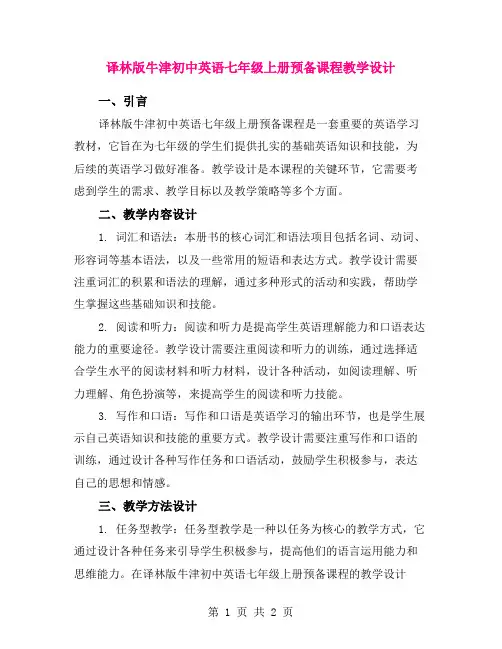
译林版牛津初中英语七年级上册预备课程教学设计一、引言译林版牛津初中英语七年级上册预备课程是一套重要的英语学习教材,它旨在为七年级的学生们提供扎实的基础英语知识和技能,为后续的英语学习做好准备。
教学设计是本课程的关键环节,它需要考虑到学生的需求、教学目标以及教学策略等多个方面。
二、教学内容设计1. 词汇和语法:本册书的核心词汇和语法项目包括名词、动词、形容词等基本语法,以及一些常用的短语和表达方式。
教学设计需要注重词汇的积累和语法的理解,通过多种形式的活动和实践,帮助学生掌握这些基础知识和技能。
2. 阅读和听力:阅读和听力是提高学生英语理解能力和口语表达能力的重要途径。
教学设计需要注重阅读和听力的训练,通过选择适合学生水平的阅读材料和听力材料,设计各种活动,如阅读理解、听力理解、角色扮演等,来提高学生的阅读和听力技能。
3. 写作和口语:写作和口语是英语学习的输出环节,也是学生展示自己英语知识和技能的重要方式。
教学设计需要注重写作和口语的训练,通过设计各种写作任务和口语活动,鼓励学生积极参与,表达自己的思想和情感。
三、教学方法设计1. 任务型教学:任务型教学是一种以任务为核心的教学方式,它通过设计各种任务来引导学生积极参与,提高他们的语言运用能力和思维能力。
在译林版牛津初中英语七年级上册预备课程的教学设计中,可以运用任务型教学,设计各种任务,如角色扮演、小组讨论、演讲等,来激发学生的学习兴趣和积极性。
2. 情境式教学:情境式教学是一种通过创设真实的或模拟的情境来帮助学生理解和运用知识的教学方式。
在译林版牛津初中英语七年级上册预备课程的教学设计中,可以运用情境式教学,设计各种情境化的教学活动,如对话练习、故事编写等,来提高学生的英语运用能力。
四、教学评估与反馈教学评估是教学设计的重要组成部分,它可以帮助教师了解学生的学习情况,及时调整教学策略和方法。
在教学设计中,教师需要注重教学评估的设计,如课堂观察、作业评价、测试等,同时也要注重学生的反馈和意见,及时调整自己的教学方式和方法。

初中预备班英语教案课程目标:1. 学生能够掌握一些基本的英语单词和句型,为初中英语学习打下基础。
2. 学生能够进行简单的英语口语交流,提高他们的语言表达能力。
3. 学生能够培养对英语学习的兴趣和自信心。
教学内容:1. 基本单词:hello, good morning, good afternoon, good evening, how are you, my name is, nice to meet you, bye bye等。
2. 基本句型:介绍自己,询问他人,回答问候等。
教学步骤:1. 热身活动(5分钟)- 教师与学生进行简单的英语口语交流,例如:问候学生,询问他们的名字、年龄等。
- 学生进行小组活动,用英语进行自我介绍,相互问候。
2. 单词学习(10分钟)- 教师展示单词卡片,引导学生跟读并记忆单词。
- 学生进行小组活动,用单词卡片进行单词接龙游戏,巩固记忆。
3. 句型练习(10分钟)- 教师给出一些基本的句型,例如:How are you? My name is...等,引导学生进行口语练习。
- 学生进行角色扮演,模拟真实场景,用所学的句型进行交流。
4. 听力练习(10分钟)- 教师播放一段英语对话或短文,学生听后回答相关问题。
- 学生进行小组活动,互相播放听力材料,讨论答案。
5. 口语表达(10分钟)- 教师给出一个主题,例如:My family,学生围绕主题进行口语表达。
- 学生进行小组活动,互相交流自己的家庭情况。
6. 总结与作业(5分钟)- 教师对本节课的内容进行总结,强调重点单词和句型。
- 学生完成作业,巩固所学内容。
教学评价:1. 观察学生在课堂上的参与程度,以及他们的口语表达能力。
2. 通过小组活动和小测验,检查学生对单词和句型的掌握情况。
3. 收集学生的作业,评估他们的写作能力。
注意事项:1. 注重学生的口语练习,鼓励他们大胆开口说英语。
2. 针对不同学生的学习水平,适当调整教学内容和难度。
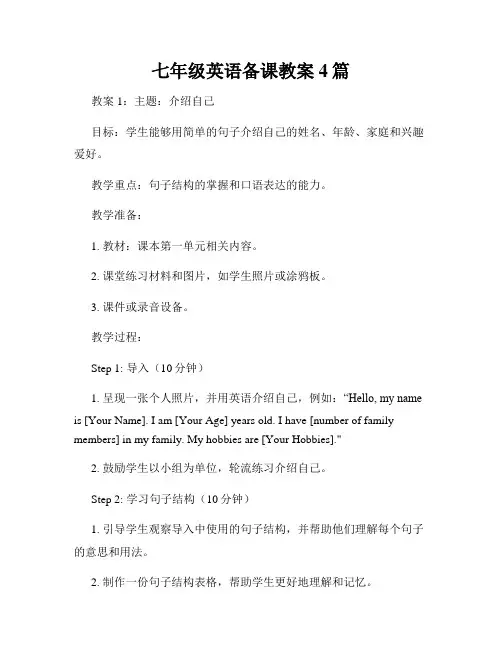
七年级英语备课教案4篇教案1:主题:介绍自己目标:学生能够用简单的句子介绍自己的姓名、年龄、家庭和兴趣爱好。
教学重点:句子结构的掌握和口语表达的能力。
教学准备:1. 教材:课本第一单元相关内容。
2. 课堂练习材料和图片,如学生照片或涂鸦板。
3. 课件或录音设备。
教学过程:Step 1: 导入(10分钟)1. 呈现一张个人照片,并用英语介绍自己,例如:“Hello, my name is [Your Name]. I am [Your Age] years old. I have [number of family members] in my family. My hobbies are [Your Hobbies]."2. 鼓励学生以小组为单位,轮流练习介绍自己。
Step 2: 学习句子结构(10分钟)1. 引导学生观察导入中使用的句子结构,并帮助他们理解每个句子的意思和用法。
2. 制作一份句子结构表格,帮助学生更好地理解和记忆。
Step 3: 输入和练习(20分钟)1. 在课件或录音设备上播放相关对话,或指导学生通过课本自学相关内容。
2. 设计一些课堂练习,如问答比赛、句子排序和填空。
Step 4: 输出和展示(15分钟)1. 要求学生用英语介绍自己的基本信息,并准备一个小展示或小演讲。
2. 学生可以使用课前准备的个人照片或涂鸦板来帮助他们表达。
3. 鼓励学生之间互相提问和交流。
Step 5: 小结(5分钟)1. 总结所学的句子结构和句型。
2. 强调学生的表现和进步,并鼓励他们继续努力。
教案2:主题:购物目标:学生能够用英语表达购物的基本需求和交流购物的情景。
教学重点:熟练掌握购物场景中的句子和词汇,并能够进行简单的交流。
教学准备:1. 教材:课本第二单元相关内容。
2. 课件或录音设备。
3. 各种购物相关图片和道具,如购物袋、水果、蔬菜等。
教学过程:Step 1: 导入(10分钟)1. 在课堂中创建一个购物场景,用英语询问学生的购物需求,并引导学生回答,例如:“Do you need any fruits? What fruits do you like?”Step 2: 学习句子和词汇(15分钟)1. 使用课件或录音设备播放相关对话或课文,或指导学生通过课本自学相关内容。

Lesson 1 Nice to meet you!※教学目标i掌握问候、介绍和告别的英语表达方式。
2学会运用人称代词提问和回答。
3学会用适当的形容词描述他人。
4学会写简单描述同学的小短文。
※教学内容词汇:classmate school new f riend cousinphoto short thin tall strongclass big small clever kind词组:a nice school have some photos have a lookshort and thin tall and strong in our classLily's dog 句型:Hi/Hello, Fm Millie.Good morning./Good afternoon.Goodbye./Bye.This is my classmate Jill./This is my cousin Andy.Nice to meet you (too).Are you Lily? Yes, I am./No, I'm not.How are you (today)? I’m fine, thank you.What's your name? I’m Millie.※教学准备i相关图片。
2学生的照片。
3配套磁带或光盘。
※教学步骤A Meeting new friendsStep I导入1 教师先打招呼并自我介绍:Hi, boys and girls, rm your new English teacher. Nice to meet you.询问学生该怎样回答,并把Nice to meet you.和Nice to meet you too.这两句写在黑板上。
2告诉学生以后见到你可以用“Hi, Miss/Mr 来跟你打招呼。
教师说:From now on, you can greet me with "Hi, Miss/Mr .…”并把该句写在黑板上。
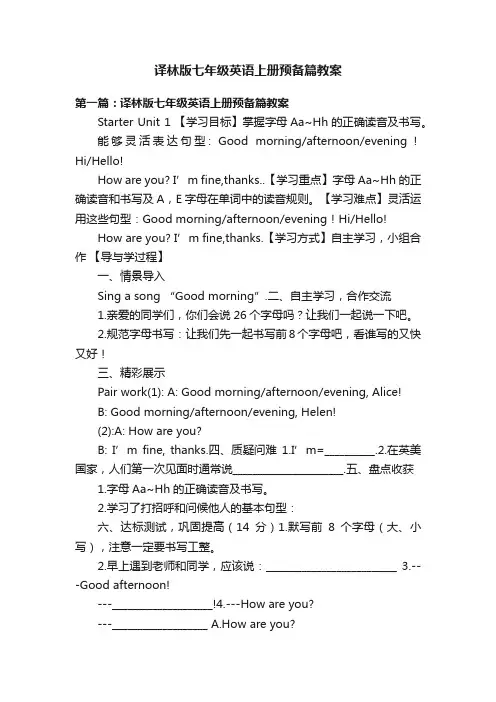
译林版七年级英语上册预备篇教案第一篇:译林版七年级英语上册预备篇教案Starter Unit 1 【学习目标】掌握字母Aa~Hh的正确读音及书写。
能够灵活表达句型: Good morning/afternoon/evening!Hi/Hello!How are you? I’m fine,thanks..【学习重点】字母Aa~Hh的正确读音和书写及A,E字母在单词中的读音规则。
【学习难点】灵活运用这些句型:Good morning/afternoon/evening!Hi/Hello!How are you? I’m fine,thanks.【学习方式】自主学习,小组合作【导与学过程】一、情景导入Sing a song “Good morning”.二、自主学习,合作交流1.亲爱的同学们,你们会说26个字母吗?让我们一起说一下吧。
2.规范字母书写:让我们先一起书写前8个字母吧,看谁写的又快又好!三、精彩展示Pair work(1): A: Good morning/afternoon/evening, Alice!B: Good morning/afternoon/evening, Helen!(2):A: How are you?B: I’m fine, thanks.四、质疑问难1.I’m=__________.2.在英美国家,人们第一次见面时通常说______________________.五、盘点收获1.字母Aa~Hh的正确读音及书写。
2.学习了打招呼和问候他人的基本句型:六、达标测试,巩固提高(14分)1.默写前8个字母(大、小写),注意一定要书写工整。
2.早上遇到老师和同学,应该说:__________________________3.---Good afternoon!---____________________!4.---How are you?---___________________ A.How are you?B.Fine, thank you.C.Good morning!5.字母的含义:HB _____________ CD__________BBC_______________七、作业布置阅读下节教材,提出你发现的有价值或困惑的问题,填写在下节“师生随笔”中;八、自我反思Starter Unit2 【学习目标】掌握字母I~R的正确读音及书写;学会句型“What’s this/that in English?” 【学习重点】字母I~R的正确读音及书写;E、O的读音规则。
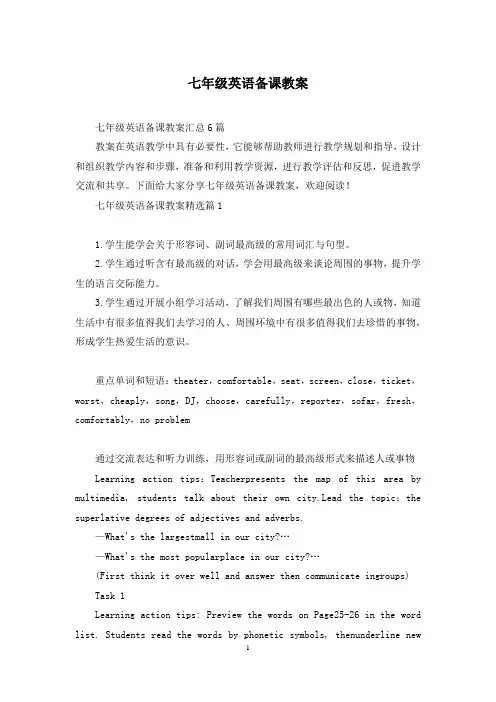
七年级英语备课教案七年级英语备课教案汇总6篇教案在英语教学中具有必要性,它能够帮助教师进行教学规划和指导,设计和组织教学内容和步骤,准备和利用教学资源,进行教学评估和反思,促进教学交流和共享。
下面给大家分享七年级英语备课教案,欢迎阅读!七年级英语备课教案精选篇11.学生能学会关于形容词、副词最高级的常用词汇与句型。
2.学生通过听含有最高级的对话,学会用最高级来谈论周围的事物,提升学生的语言交际能力。
3.学生通过开展小组学习活动,了解我们周围有哪些最出色的人或物,知道生活中有很多值得我们去学习的人、周围环境中有很多值得我们去珍惜的事物,形成学生热爱生活的意识。
重点单词和短语:theater,comfortable,seat,screen,close,ticket,worst,cheaply,song,DJ,choose,carefully,reporter,sofar,fresh,comfortably,no problem通过交流表达和听力训练,用形容词或副词的最高级形式来描述人或事物 Learning action tips:Teacherpresents the map of this area by multimedia, students talk about their own city.Lead the topic:the superlative degrees of adjectives and adverbs.—What's the largestmall in our city?…—What's the most popularplace in our city?…(First think it over well and answer then communicate ingroups) Task 1Learning action tips: Preview the words on Page25-26 in the word list. Students read the words by phonetic symbols, thenunderline newwords in the text and mark the Chinese meaning. At last finish thetask in 1a.▲辨析sound/voice(1)sound指发出来的各种各样的声音。
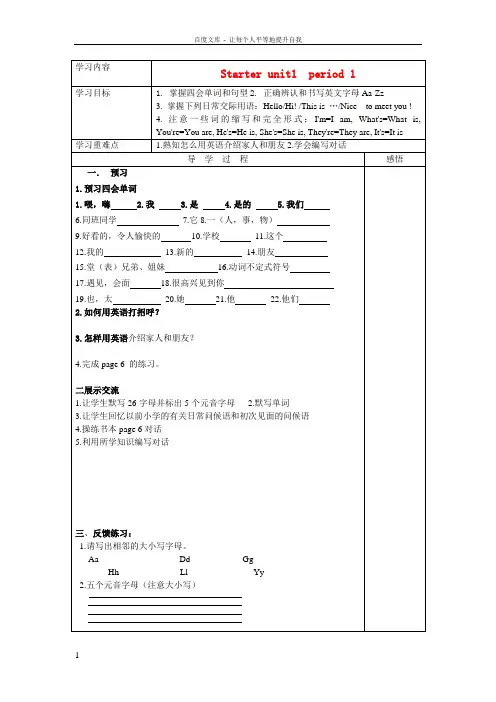

初中英语预备课程电子版篇一:最新版牛津英语七年级预备课程Stater 教案Lesson 1 Nice to meet you! Part A教学目标: 1. Master the letters from Aa to Nn. Can read and write them correctly.2. Learn how to greet others. Can make conversations with new friends.重点1. Master the words: I, You, We, I am=I?m, You are=You?re, We are=We?re2. Master the sentence patterns: I?m---. Nice to meet you.难点1. Master the sentence pattern: Are you---? And can give correct answers.2. Can make conversations with new friends.【个体学习】1. Write the letters from Aa to Nn. Make sure everyone can read and write correctly.2. Introduce myself to the Ss and encourage them to introduce themselves.My name is ---. I?m ---.3. Have the Ss introduce their partners freely.4. Ask the Ss to look at the four pictures on page 6 and then read the conversations bythemselves. Focus on the key sentences: Are you ---? I?m ---. This is ---. Nice to meet you.5. Listen to the tape and read after it.6. Focus on A2 and try to complete the four sentences.7. Learn to greet each other by using the following sentence structures.Good morning/ afternoon/ evening/ night.What?s your name?I?m ---. How are you today? I?m fine. Thank you. Goodbye.【同伴互导】1. Encourage the Ss to greet their partners.2. Ask the Ss to read the conversations in Part C on page eight.3. Read after the tape and try to act it out.4. Read and master the useful expressions on page 9.【教师解难】1. T alk about the difficulties in groups.2. Give the Ss some explanations if necessary.【练习检测】一英汉互译。
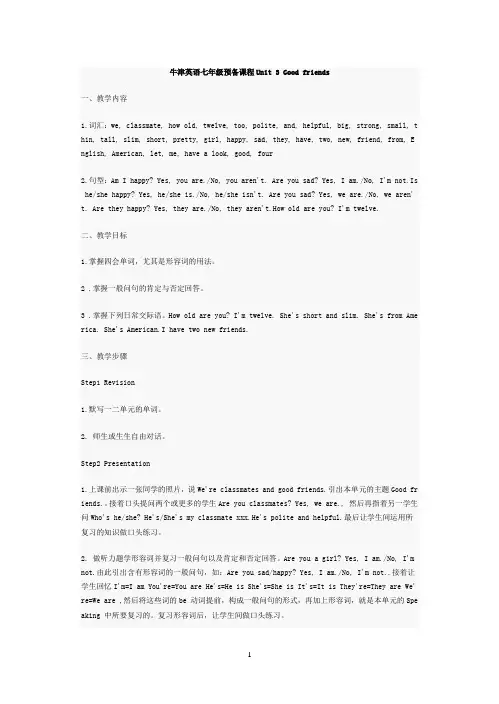
牛津英语七年级预备课程Unit 3 Good friends一、教学内容1.词汇:we, classmate, how old, twelve, too, polite, and, helpful, big, strong, small, t hin, tall, slim, short, pretty, girl, happy, sad, they, have, two, new, friend, from, E nglish, American, let, me, have a look, good, four2.句型:Am I happy? Yes, you are./No, you aren't. Are you sad? Yes, I am./No, I'm not.Is he/she happy? Yes, he/she is./No, he/she isn't. Are you sad? Yes, we are./No, we aren' t. Are they happy? Yes, they are./No, they aren't.How old are you? I'm twelve.二、教学目标1.掌握四会单词,尤其是形容词的用法。
2 .掌握一般问句的肯定与否定回答。
3 .掌握下列日常交际语。
How old are you? I'm twelve. She's short and slim. She's from Ame rica. She's American.I have two new friends.三、教学步骤Step1 Revision1.默写一二单元的单词。
2. 师生或生生自由对话。
Step2 Presentation1.上课前出示一张同学的照片,说We're classmates and good friends.引出本单元的主题Good fr iends.。
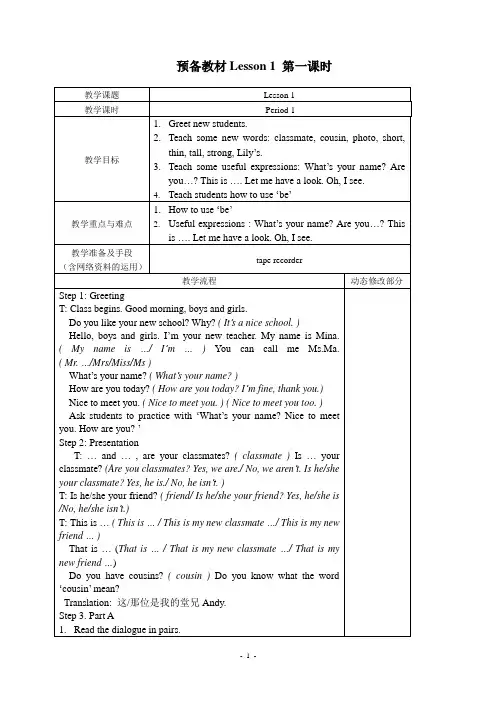
预备教材Lesson 1 第一课时预备教材Lesson 1 第二课时预备教材Lesson 2 第一课时预备教材Lesson 2 第二课时Lesson 3 A nice school Period 1Lesson 3 A nice school Period 2Lesson 4 You look cool! Period 1Lesson 4 You look cool! Period 2预备教材Lesson 5 第一课时预备教材Lesson 5 第二课时预备教材Lesson 6 第一课时预备教材Lesson 6 第二课时Lesson 7 Enjoy our days (PartA)教学目标1.To learn the subjects at school.2.To master how to talk about school days.3.To be able to introduce one’s week.重点To master how to talk about school days.难点To be able to introduce one’s week.教学准备Multi-media, tape recorder教学设计详案二次备课内容Step 1 Revision and lead-in1. T: Good morning, boys and girls. What day is today?Ss: Today is……T: How many days are there in a week? What are they?Ss: ……2.T: Every day, you have seven lessons at school. What s ubjectsdo you have today?S1:……T: How many English lessons do you have today?S2: ……T: How many Ch inese lessons do you have today?S3: ……T: What about Math/ Science/ PE?(通过真实情况,呈现主要课程的名称)Step 2 DiscussionT: Now let’s have a discussion about subjects in a week.Q1: What subjects do you have on Monday / Tuesday /Wednesday / Thursday / Friday?Q2: How many Chinese / Math / English / Art / Music / Science/ Computer / PE lessons do you have every week?2. Ask Ss to present their results.Step 3PresentationT: Look , this is an email. It’s from Nick to Tony. What day does Nick love? Why?T: Read the text and answer the questions.What subjects does Nick have every day?What subjects does Nick have on Monday and Wednesday? What about Tuesday and Thursday?T: Read the text and tell true or false.Nick gets up early in the morning every day.Nick walks to school every day.Nick’s classes begin at nine.Nick goes to school on Saturday aft ernoon.Nick wants Tony to write ba ck.(适时呈现get up, early, walk, at eight, go to school, etc.)T: Let Ss discuss about “What subjects do you like? Why? What day do they like i n a week?”After that, a sk Ss to present their report.Step 4 PracticeLet Ss read the text after the tap e and then complete the ta ble in Part A2.Step 4 Summary作业设计1.Learn the text by heart.2.Preview Part B.教学反思Lesson 7 Enjoy our days (PartB)教学目标1.To master the seasons and months of the year.2.To be able to use “in”, “on” and “at”correctly.重点To be ab le to master the seasons and months of the year.难点To be able to learn the differences between “in”, “on” and “at”.教学准备Multi-media教学设计详案[来源:学+科+网Z+X+X+K]二次备课内容Step 1 RevisionT: When do you get up in the morning?Ss:……T: When do you go to school?Ss: ……T: When do your classes begin?Ss: ……(鼓励学生简单介绍自己一周的学习和生活)Step 2 Presentation1.Show Ss a clock.2.T: Look at the clock. What time is it? It’s 9:30 at night. Mi llieoften goes to bed at 9:30 and has a good sleep. What aboutyou? When do you go to bed at night? Do you have a goodsleep?(呈现go to bed, at night 和have a good sleep)3. Present a picture of flying kites..T: What do you often do in spring? Do you like playing in theopen air? Do you like flying kites? (呈现in the open air和flykites)4. T: What do you often do on Saturday or Sunday? Do you go toschool? Do you get up early in the morning? How many days are there in a week? How many weeks are there in a month? How m any months are there in a year? How many seasons are there in a year? (呈现month、season、spring、summer 、autumn和winter.5. Tell Ss a year has 12 months and what they are. Let them t alk about things they can do in different months and seasons.Step 3 PracticeAsk Ss to make up dialogues in pairs using what they have learnt before and encourage them to act them out.Step 4 PresentationLet Ss listen and tell “T” or “F”.Millie often goes to bed at 9:00 in autumn. ( )The Chinese New Year is in January or February. ( )It is warm and windy in spring. ( )Students have a short holiday in summer. ( )Ask Ss to complete Part B2 and work out the rule.Let Ss read the text after the tape and then ask them to read Part B3 together.Step 5 PracticeLet Ss make a dialogue to talk about all kinds of festivalsStep 6 Summary作业设计1. Learn the passage by heart.2. Complete the exerci ses.教学反思Lesson 7 Enjoy our days (PartC, D)教学目标1. To enable Ss to talk about their activities in their everyday life.2. To be able to write a simple article of their week.重点To enable Ss to talk about their activities in their everyday life.难点To be able to write a simple article of their week.教学准备Multi-media教学设计详案二次备课内容Step 1 Revision and lead-inT: What time do you get up/ have breakfast/ go to school/ havelunch/ have dinner/ go to bed every day?Ss: …..T: What time does your mum/ dad cook dinner every day?Ss: …..T: What time do your classes begin every day?Ss: …..T: What time do you often……?(适时引出o’clock、half past等表达方式)Step 2 Presentation1. Show the Ss some photos, and ask the students somequestions.What do the boys often do after school? What does Ni ck doafter dinner? (呈现do sports、play basketball、do homework和inthe eve ning等)2. Listen and tell “T” or “F”.Nick gets up at six forty in the morning. ( )Nick often plays football at four o’clock in the aftern oon. ( )Nick often does his homework at half past five after dinner. ( )Nick often goes to bed at nine twenty in the evening.( )3. Ask Ss to read after the tape and then read t ogether and in roles.Step 3 Practice1. Ask students to finish a timetable according to their every day life. Let Ss make a dialogue and act it out.2. Ask: What do you often do at six o’clock in the morning? What do you often do at half past seven in the evening? (呈现go to work、come back、get home、cook dinner、wash clothes and watch TV等).3. T: When do your parents go to work every day? What time does your mother/ father get up in the morning? What time does your mother/ father cook dinner?4. Let Ss to complete Part D according to their own in formation. Step 4 Summary作业设计Write an article about your own busy week.教学反思Lesson 8 Let’s have fun! Period 1教学目标1. Learn some new words: sunny, great, plants and so on.2. Learn some useful expressions: go out, good idea, by bus/bike/car/plane, wait long, go boating on the lake and so on.3. Can express the traveling ways.Know the meaning of going out and having fun.重点Master new words and useful expressions.难点Can you make traveling plans.教学准备Multi-media教学设计详案二次备课内容Step 1 RevisionHave students work in pairs and make dialogues with ‘Whattime do you …?’Have students say something to describe his/her day.Step 2 Presentation1. T asks questions like:What do you often do on Saturday?Do you want to go out to have fun? ( go out, have fun ) Where doyou want to go? ( go to the cinema, go to the park )What do you want to do there? ( see a film, go boating on thelake )How do you get there? ( get there, by bus/bike/plane/taxi, onfoot )Do you know how I like going there? ( see plants and trees onmy way, The streets are busy, I need to wait long. )2. Finish Part A, Workbook.Step 3 Part AAsk students to read the dialogue by themselves.Ask one to read it for others.Have students answer questions like:Where does Peter want to go? How does he get there? Where does Sally want to go? How does she get there? Ask students to finish Part A2.Read the dialogue after T.Real play reading.Step 4 ConclusionStep 5 HomeworkRecite the dialogue.Remember the new words and phrases.作业设计Write an article about your own busy week. 教学反思Lesson 8 Let’s have fun! Period 2教学目标1. Learn some new words: farm, cow, horse, sheep, beside, under and so on.2. Learn some useful expressions: It takes some time to do sth, swim in the river and so on.3. Can use prepositions to express directions correctly.重点New words and phrases.难点The use of prepositions of place.教学准备Multi-media教学设计详案二次备课内容Step 1 RevisionT: Do you want to go out? Where do you want to go? (Is it faraway from your home/our city?) How do you go there?Ask two pairs to recite the dialogue in Part A1.Step 2 PresentationShow the picture in Part B1. Look at the boy. He’s on a farm.What can you see on the farm? ( cow, horse, grass, house, duck,river ).Where are the cows, horses and sheep? ( on the grass )Where is the big tree? ( beside the house )Where is the dog? ( under the tree)Where are the ducks? ( behind the tree)Where is the river? ( near the house , swim in the river )Where is the boy? ( in front of the house )Where are the birds? ( in the tree)Where is the tree? ( on the left of the house )Where are the animals? ( on the right of the house)Where are the horses? ( between the cows and the sheep )Ask students to make dialogues with those prepositions with the help of things in the classroom.Where is/are …? It’s/They’re …Step 3 Part BAsk students to read the text by themselves.Ask one to read it for others.Ask one student to be a reporter and ask questions like:Where do you often go in summer?Where’s the farm?How do you get there?What’s on the farm?What do you do on the farm?Read the text after T, and then read it together.Finish Part B2.Have students to read dialogues in Part B3.Finish Part B3, Workbook.Step 4 ConclusionStep 5 HomeworkAsk students to recite the text.作业设计Write an article about your own busy week.教学反思Lesson 8 Let’s have fun! Period 3教学目标1. Practice oral English to talk about a trip.2. Writing about a trip.重点Talk about a trip.难点Writing about a trip.教学准备Multi-media教学设计详案二次备课内容Step 1 Revision.1.Ask two students to recite the text in Part B1.2.T asks several questions, students have to answer the questionswith ‘in/on/beside/under/behind/near/in front of/ on theleft/right of /between…and…’.Step 2 Presentation1.T: Where do you want to go this Saturday?How do you get there?What can you do there? (can see, learn about )2.Ask students to make dialogues like that.Step 3 Part C1.Ask students to read dialogues in Part C and answer questionslike:Where does Millie want to go this Saturday?What can you see in a zoo?Where does Nick want to visit this Sunday?What can he learn there?2.Ask two pairs to read the dialogues.3.Role-play reading.Step 4 Part D1.T: Where do you want to go? Where is the place? How can youget there? What can you do there? Please write down your ideas.2.Ask students to finish the writing in Part D, and then have twoto read it out.3.Finish Part D, Workbook.Step 5 ConclusionStep 6 Homework1.Go on practice dialogues with ‘where/how/what’.Recite the words in Lesson 8 for a dictation.作业设计Write an article about your own busy week.教学反思。

七年级英语备课教案4篇七年级英语备课教案篇1教学目标知识与技能(1)熟练掌握下列词汇:rules, arrive, late, hall, dinning hall, listen, , fight, sorry outside,wear, important, bring, uniform, quiet(2)熟练掌握下列短语:dining hall, arrive late for school, (be) on time, listen to music break the rules, in class, be/ keep quiet, a lot of, bring …to…,weara hat, have to, music players(3)掌握下列句型:1. Dont eat in class.2. You must be on time.3. Eat in the dining hall.4. 正确使用情态动词can, can’t——Can we wear a hat in school?——Yes, we can./No, we can’t.5. 能正确使用have to 和 must 谈论规章制度We must be on time/ We also have to be quiet in the library.教学重难点重点:1) 肯定祈使句是省略掉主语的原形动词开头;2) 否定祈使句则是在肯定祈使句前加上“don’t”。
3) 情态动词must及have to在用法上的区别。
难点:掌握祈使句的用法,并能听懂、会说一些简单的祈使句。
教学工具ppt教学过程一.新课预习1.小组合作学习本课单词,根据汉语写出下列英语单词。
规则_______ 到达_________ 准时___________走廊___________礼堂_________ 餐厅_______________倾听___________________听……______________打架_______________抱歉的_____________ 非常重要_____________ 带来;拿来_________________不得不_____________ 校服;制服_________________2.试着翻译下列句子。
初一英语备课教案初一英语备课教案(精选5篇)教案通过设计合适的教学活动,激发学生的兴趣,提高他们的学习积极性。
它对学生的学习进行分阶段和分步骤的引导,使得学习过程更加有针对性和有效性。
下面给大家分享初一英语备课教案,欢迎阅读!初一英语备课教案(篇1)Unit 1 Topic 3 How old are you ?Section D学习目标1.学习以短文形式谈论姓名、年龄、学校、班级和电话号码等个人信息2.能读懂短文并能从简单的名片中获得信息3.能向大家做自我介绍学习重点以短文形式谈论姓名、年龄、学校、班级和电话号码学习难点第一人称和第三人称的转变学习过程(一)导入(二)自学指导1、预习课本P23 Part 1 ,复习书上的六个音标2、预习课本P23 Part 2 ,分别找出Jane 和 Huang Hua 的个人信息3、预习P23 Part 3 ,根据所给信息把空补充完整4、背诵课本P24 Part 4a 4b(三)问题导学再看课本P22 Part 2 ,回答问题。
Where is Jane from ?__________________________How old is she ?___________________________What class is she in ? _____________________Where is Huang Hua from ? _______________What’s his English name ? _____________________Are they in the same class ? ______________(四)典题训练(五)精讲点拨1、They are not in the same class ,but they good friends.他们不在同一个班,但是他们是好朋友。
解析:same 意思是“相同的”,前面一定要用定冠词“the”,后面接单数名词。
初中英语新预备课程教案1. Introduction初中英语新预备课程是为初中生准备的英语学习课程,旨在为学生提供一个良好的英语基础,为高中英语学习打下坚实的基础。
本教案将涵盖该课程的教学内容、教学目标和教学方法。
2. Teaching Content初中英语新预备课程的教学内容主要包括以下方面:2.1 Phonetics英语语音是英语学习的重要基础,初中英语新预备课程将重点讲解英语发音的基本知识,包括元音和辅音的发音、重读和非重读音节、英语语调等。
2.2 Vocabulary词汇是英语学习的重要基础,初中英语新预备课程将通过各种方式,如单词记忆、阅读理解、课文背诵等,扩大学生的词汇量,并帮助学生提高词汇记忆和应用能力。
2.3 Grammar语法是英语学习的重要组成部分,初中英语新预备课程将讲解英语语法的基本知识,如时态、语态、主谓一致、虚拟语气等,帮助学生掌握英语语法的基本规则。
2.4 Sentence Patterns英语句型是英语语言的重要组成部分,初中英语新预备课程将讲解英语常用的句型,如简单句、复合句、疑问句、否定句等,帮助学生掌握英语的基本句型结构。
2.5 Reading and Writing阅读和写作是英语学习的重要组成部分,初中英语新预备课程将通过阅读和写作提高学生的语言应用能力,包括阅读理解、短文写作、作文写作等。
3. Teaching Objectives在本课程教学过程中,我们旨在帮助学生:3.1 Improve Pronunciation通过学习英语语音和语调,帮助学生正确发音,表达自己的想法。
3.2 Expand Vocabulary通过各种方式扩大学生的词汇量,帮助学生提高词汇记忆和应用能力。
3.3 Master Grammar通过讲解英语语法和句型,帮助学生掌握英语语言的基本规则。
3.4 Enhance Reading and Writing Skills通过阅读和写作提高学生的语言应用能力,包括阅读理解、短文写作、作文写作等。
Lesson 1 Nice to meet you!※教学目标i掌握问候、介绍和告别的英语表达方式。
2学会运用人称代词提问和回答。
3学会用适当的形容词描述他人。
4学会写简单描述同学的小短文。
※教学准备i相关图片。
2学生的照片。
3配套磁带或光盘。
※教学步骤A Meeting new friendsStep I导入1 教师先打招呼并自我介绍:Hi, boys and girls, rm your new English teacher. Nice to meet you.询问学生该怎样回答,并把Nice to meet you.和Nice to meet you too.这两句写在黑板上。
2告诉学生以后见到你可以用“Hi, Miss/Mr 来跟你打招呼。
教师说:From now on, you can greet me with "Hi, Miss/Mr .…”并把该句写在黑板上。
Step II呈现教师说:Now you're in this new school. What do you think of it?鼓励学生回答:It's a nice school.教师说:This is a new class. Can you tell me your names?教师挥手跟任意一位学生打招呼并自我介绍:Hi, I'm Miss/Mr….鼓励学生用“Hi, I'm…•”回应。
3安排同桌的学生用“Hi, 互相介绍。
教师说:Now introduce yourself to your partner, please. Don't forget to use "Hi”.4 告诉学生:Today we're going to meet four new friends. Listen to the tape.教师播放录音,听完后问学生:Can you tell me their names?让学生集体回答。
初一英语预备教学方案:Visitmyschool2:Visitmyschool一、教学目标:通过本次英语预备教学,学生能够达到以下目标:1.了解学校的各个部分和服务内容,并掌握相关的英语表达;2.学习交通工具、地点以及时间的英语表达;3.提高学生听、说、读、写四个方面的英语能力,培养他们的英语学习兴趣。
二、教学内容:1.掌握英语表达学校的各个部分和服务内容2.学习交通工具、地点以及时间的英语表达三、教学方法:1.听力训练:通过听力材料进行听力训练,让学生熟悉英语的语音、语调和语音连续性。
2.阅读练习:让学生认真阅读相关材料,并随着老师的指导进行朗读,增强语感和语言表达能力。
3.口语练习:通过游戏和互动的方式,让学生互相交流并进行英语口语练习。
4.写作练习:通过看图片和描述,让学生进行英语作文写作练习。
四、教学步骤:Step 1:准备活动1.问候学生,介绍教师并进行自我介绍。
2.介绍本次课程的主要内容和教学目标。
3.通过出示各种图片来引导学生熟悉英语的学校词汇。
Step 2:讲解学校各部分和服务内容的英语表达1.通过PPT讲解学校的各部分和服务内容,在PPT中穿插相关的练习题进行交互。
2.分组训练,让学生设计PPT并介绍不同学校部分的英语表达,增强口语表达能力。
Step 3:学习交通工具、地点以及时间的英语表达1.通过练习,让学生学习交通工具的英语表达,例如:“subway”、“bus”、“taxi”等等。
2.通过游戏和文章,让学生熟悉地点和时间的英语表达,例如:“in the morning”、“at the mall”、“at the park”等等。
Step 4:口语练习1.让学生分组进行交流训练,设计游戏和练习题,让学生进行口语练习。
2.播放听力材料并让学生进行朗读,增强语感和语言表达能力。
Step 5:写作练习1.让学生阅读图片和描述,并使用所学的英语词汇进行作文写作练习。
2.分组训练,让学生分享自己的作品并进行口头表达练习。
(一)七年级英语预备课程教学案Unit 8 our thingsTeaching periods:1st period一、Teaching Aims and demands:1.Learn the new words:walkman comic watch radio computer scarf sticker hair clip locker apple pear a pair of sunglasses beside snake can coke trainer pet goldfish duck chicken rabbit yours mine hers theirs ours2.Drills:(1).Do you have……?Yes,I do./No, I don’t have any.(2)Whose ……is this/that?Is it yours, Nick? No, It’s not mine. It’s _______.(3)Whose……are these/those?Are they yours, Andy? Yes, they are mine.3.To master and use 名词性物主代词correctly.二、Important and difficult points:To master the new words and drillsTo use the two kinds of pronouns correctly:my your his her its our your theirmine yours his hers its ours yours theirs三、Teaching stepsStep1. learn to say (welcome to the unit)Find out the new words and try to read them in groups.Read the dialogue freely and act it out in pairs.Step2. Listening B (listening)Listen and tickStep3. Ask and answer (speaking)Read the dialogue and act it out. Make a dialogue with parteners and act it out. To master and use 名词性物主代词correctly四、Consolidation exercises五、Follow-up lessons to help(二)七年级英语预备课程巩固练习Unit 8 our thingsTeaching periods:3rd period一、选择划线部分读音不同的选项( ) 1. A. happy B. family C. what D. can( ) 2. A. job B. comic C. doctor D. walkman( ) 3. A. locker B. hers C. others D. secondary( ) 4. A. coke B. door C. ball D. floor( ) 5. A. look B. good C. too D. book二、词汇A)根据句意或首字母填入所缺单词1. Do you have any comic b_______? What a______ your sister?2. Nick’s c_______ has a basketball.3. Millie doestn’t have any hair c______. But Lily h_____ some.4. These are their rackets. O______ are in the classroom.5. What d_____ Li Fen have in her box?B) 用所给词的适当形式填空1. _________(who) model plane is this?2. -Is this your _______ (brother) photo? --No, it’s_______(my)3. What _______ they_______(have) in their lockers?4. Could you give tow _______(can) of Coke?5. There are three _______(pair) of trainers . Whose are they?6. The students don’t have _______(some) pets.三、选择正确的答案( )1.---they have a basketball?---No, they don't have _____.A. Are, one B Are, a C. Do, one D. Do, a( ) 2.---Do you have any story books? ---Yes, I have _____. A. books B. any C. some D. a( ) 3.Are these pictures_____? A. your B. yours C .you D. yours' ( )4.We_____any pets A. don't have B. have no C. have not D. aren't have ( ) 5.There _____an apple and some _____on the desk A. is, watchs B. is ,watches C. are, watchs D. be, watches( ) 6.My brother has two _____ in his room. A. pair of sunglass B. pairs of sunglass C. pair of sunglasses D. pairs of sunglasses( )7.What_____the girl ____in her box? A. do , has B. does , have C. do , have D. does ,( )8._____the left of the old man , there is a tree. A. On B. In C. At D. Beside( )9.In_____,there are some red hair clips. A. Lily box B. Lily's box C. Lilys' box D. the Lily's box( )10.The purple flowers aren't ______. They are ______. A. our , their B. ours , their C. our , theirs D. ours , theirs( )11.I _____snacks. A. have no B. am not have C. have not D. not have ( )12.These aren’t _____pets. They ‘re_____. A. he’s , hers B. his , her C. his , hers D. his , she’s( )13.______the boy beside the window? A. Whose is B. Which is C. Who’s D. Where’s( )14.---What’s that?---Let me _____. Oh , it’s a rubber. A. have look B. see C. to look D. to see( )15.---Is this locker_____ or ______? ---It’s Millie’s. A. Millie, Lily B. Millie’s, Lily C. Millie, Lily’s D. Millie’s, Lily’s四.根据汉语意思完成句子1. ---尼克,这个飞机模型是你的吗?---不是我的。
Lesson 1 Nice to meet you!※教学目标i掌握问候、介绍和告别的英语表达方式。
2学会运用人称代词提问和回答。
3学会用适当的形容词描述他人。
4学会写简单描述同学的小短文。
※教学内容词汇:classmate school new friend cousinphoto short thin tall strongclass b ig small clever kind词组:a nice school have some photos have a lookshort and thin tall and strong in our classLily's dog 句型:Hi/Hello, Fm Millie.Good morning./Good afternoon.Goodbye./Bye.This is my classmate Jill./This is my cousin Andy.Nice to meet you (too).Are you Lily? Yes, I am./No, I'm not.How are you (today)? I’m fine, thank you.What's your name? I’m Millie.※教学准备i相关图片。
2学生的照片。
3配套磁带或光盘。
※教学步骤A Meeting new friendsStep I导入1 教师先打招呼并自我介绍:Hi, boys and girls, rm your new English teacher. Nice to meet you.询问学生该怎样回答,并把Nice to meet you.和Nice to meet you too.这两句写在黑板上。
2告诉学生以后见到你可以用“Hi, Miss/Mr 来跟你打招呼。
教师说:From now on, you can greet me with "Hi, Miss/Mr .…”并把该句写在黑板上。
Step II呈现教师说:Now you're in this new school. What do you think of it?鼓励学生回答:It's a nice school.教师说:This is a new class. Can you tell me your names?教师挥手跟任意一位学生打招呼并自我介绍:Hi, I'm Miss/Mr….鼓励学生用“Hi, I'm…•”回应。
3安排同桌的学生用“Hi, 互相介绍。
教师说:Now introduce yourself to your partner, please. Don't forget to use "Hi”.4 告诉学生:Today we're going to meet four new friends. Listen to the tape.教师播放录音,听完后问学生:Can you tell me their names?让学生集体回答。
5让学生看A1部分的图片,然后提问:Picture 1: Who are they? (They are Millie and Jill.)Picture 2: What are they talking about? (They are talking about their school). Picture 3: Who is introducing Jill? (Millie is introducing Jill.)Picture 4: Who is Andy? (He is Millie's cousin.)6播放录音,要求学生集体跟读对话,教师说:Now read the conversation after the tape.播放录音时可一句一停,以便学生跟读。
7请学生看图复述对话内容。
8把学生分成三人一组进行分角色朗读,并给学生几分钟时间准备,之后请两到三个小组上台表演。
让他们用自己的真实姓名表演,达到活学活用的效果:Would you please come to the front and act out the conversation for us? You may use your own names to greet each other.Step III 练习1把学生分成三人一组,一人介绍另外两人彼此认识。
Sample conversationSI: This is my new friend ....S2: Hi, .... Nice to meet you.S3: Hi, .... Nice to meet you too.2全班同学互相认识后,以小组为单位从前到后依次快速打招呼。
使用句型“Hi, •…”和“Are you…?”并用yes/no回答。
Step IV呈现1呈现A1部分的学生图片,教师问:Who's the girl/boy?鼓励学生用人称代词he、she、they回答问题。
2完成A2部分的练习。
3教师介绍人称代词以及be动词的完整和缩写形式,向学生解释:I'm = I am、You're = You are等,前者是后者的缩写形式。
要求每位学生用I、you、we、he、she、they、it来介绍同学和教室里的物品,内容不重复。
Step V巩固1背诵对话。
2完成书后配套练习的相关部分。
B Photos of friendsStep I导入1教师在黑板上画一只钟,显示上午的某一个时间,问学生此时应该怎样用中文跟教师或同学打招呼:At this time of the day, how do you greet your teachers or classmates in Chinese?当学生回答“早上好”时,教师说出“Good morning!” 并把该句写在黑板上。
2假设当时是上午九点,让学生用“Good morning!”与同桌互致问候:It's nine o'clock in the morning now. How do you greet your partner?Step II呈现1教师和一位学生进行示范问候:Good morning!告诉学生可简略回答:Morning!2 告诉学生如何问候认识的人:Now I know you all and you all know me. How do we greet each other when we meet again? I would say "How are you?"然后要求学生跟读:Now repeat it after me: How are you?重复多次,确保每位学生都能正确模仿。
3当学生最后一次跟读“How are you?”时,教师回答:I'm fine, thank you.并在黑板上画一张笑脸。
教师再将“I'm fine, thank you.”重复多遍让学生跟读,并把“How are you?”和“I'm fine, thank you.”都写在黑板上。
然后问能力较弱的学生:How are you?启发他们回答:I'm fine, thank you.还可启发能力较强的学生进一步询问“And you?”教师回答:I'm fine too.4同一列学生前后依次问答,练习这段对话。
呈现B1部分的学生图片,问:Who are they?讨论每张图片中的学生:Who is he/she? Is she short? Is he strong?让学生用yes/no回答。
6学生分角色朗读对话。
7鼓励学生指着课本上的图片表演对话。
8展示几张班上学生的照片,要求学生模仿B1部分用真实信息改编对话。
Step III 练习1完成B2部分的表格。
2完成表格填写后,教师每说一个人称代词,学生齐声说出相应的be动词形式。
教师也可依次请一位学生来回答,最后帮助学生总结规律。
Step IV呈现教师说:Now I want to know if I can remember all your names.走到学生面前问:Are you right?引导学生回答:Yes, I am./No, I'm not.也可问学生同学的姓名:Is he/she right?引导学生回答:Yes, he/she is./No, he/she isn't. 2让学生两人一组用这种一般疑问句进行对话。
3引导学生操练B3部分的对话,用一般疑问句向学生提问:Are you ...? Is she tall? Are they classmates?让学生用yes/no回答,并在其后用肯定或否定形式完整表述。
4提醒学生注意否定的缩写形式。
5教师播放B3部分的录音,要求学生集体跟读对话。
教师说:Now read the conversations after the tape.播放录音时可一句一停,以便学生跟读。
6学生两人一组用同学的真实身份模仿B3部分的句型进行对话。
Sample conversationSI: Is she thin?S2: No, she isn't. She isn't thin.SI: Is she ...?S2: Yes, she is. She's ....Step V巩固1背诵对话。
2完成书后配套练习的相关部分。
C Greeting each otherStep I导入1教师在黑板上画一只钟,钟面显示两点整。
教师说:It's two o'clock in the afternoon. Can I say “Good morning" to you?启发他们回答:No.进一步引入“Good afternoon!”并将该句写在黑板上。
2教师假装要离开,边走向门口边对学生挥手说“Goodbye!”,鼓励学生用“Goodbye!” 回应:I'm leaving. I say goodbye to you. What do you say to me?鼓励学生说出“Goodbye!”然后把“Goodbye!”写在黑板上。
告诉学生,在和熟悉的人告别时还可以简单地说“Bye”或“Bye-bye”。
教师说:You can say "Bye!" or "Bye-bye, for short. Step II呈现1走到一个学生面前说:Hello! What's your name?启发学生回答:Hello! I'm ....告诉学生,跟“Hello” 相比,“Hi” 更口语化:"Hi" is more informal than "Hello". We usually greet our friends with "Hi”.3与多位学生练习这个对话,直到被提问的学生都能正确回答为止。